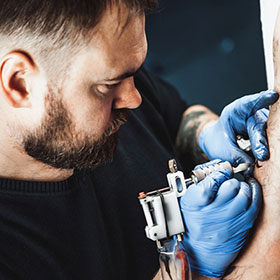Yes, arm tattoos can hurt. The pain level varies by person and tattoo placement.
Getting a tattoo is a unique experience. Some people feel more pain than others. The sensation depends on factors like skin sensitivity, the tattoo’s size, and the artist’s technique. Areas with less muscle or fat, like the inner arm, tend to hurt more.
But don’t let fear stop you from getting a tattoo. Understanding what to expect can help ease your mind. In this blog post, we will explore the factors that influence pain and tips to manage discomfort. Read on to find out more about arm tattoos and the pain involved.
Introduction To Arm Tattoos
Wondering if arm tattoos hurt? The pain varies depending on the area and your pain tolerance. Generally, biceps and forearms are less painful.
Popular Designs
Arm tattoos are very common. People choose them for different reasons. Some like simple designs. Others prefer complex ones. Flowers and tribal patterns are popular. Names and quotes are also favorite choices. Each design has its own meaning. The arm is a great spot for tattoos.
Cultural Significance
Tattoos have a long history. In some cultures, they show bravery. In others, they mark important life events. Many people get tattoos to remember someone. Others use them to show their beliefs. Each tattoo tells a story. The arm is a visible place for these stories.
Pain Factors Explained
Skin sensitivity varies for each person. Some people have more sensitive skin. This can make the tattooing process feel more painful. Tattoos on thin skin areas can hurt more. Areas with more nerve endings can also be more sensitive. These areas may include the inner arm or wrist.
The placement of a tattoo matters. Areas with more muscle may hurt less. Bony areas like the elbow can hurt more. The outer arm usually hurts less than the inner arm. Consider these factors before choosing your tattoo spot. Knowing where it hurts more can help you decide.
Types Of Pain
Sharp pain can feel like tiny needles poking your skin. Some people describe it as a cat scratch. This pain is quick and sudden. It might make you flinch. It is usually felt when the tattoo artist outlines the tattoo.
Burning sensation feels like a sunburn. It is a more intense pain. This pain happens when the tattoo artist shades or colors in the tattoo. The skin can feel warm and sore. It may last longer than sharp pain.
Pain Variation By Arm Area
The upper arm is often the least painful spot for a tattoo. The skin here is thick and there are fewer nerves. Most people feel only a slight discomfort. This area is popular for first tattoos.
The forearm can be a bit more sensitive. The inner forearm has more nerves and can hurt more. The outer forearm is usually less painful. Many people describe it as a tolerable pain.
The elbow and wrist are among the most painful areas. The skin is thin and close to the bone. Nerves are more exposed here. Many people find these spots very uncomfortable. The pain can be sharp and intense.
Pre-tattoo Preparation
Think about why you want the tattoo. Be sure about your choice. Talk to friends with tattoos. Hear their experiences. Understand that pain is part of the process. Stay calm and positive. Prepare your mind for the needle.
Get a good night’s sleep. Eat a healthy meal before your appointment. Drink plenty of water. Avoid alcohol and drugs. Wear comfortable clothes. These steps help your body handle the stress. Your body will heal faster too. Follow these tips for a better tattoo experience.
During The Tattoo Process
Getting a tattoo can hurt. Arm tattoos may cause a sharp or burning pain. Some parts of the arm are more sensitive. Areas near bone, like elbows, hurt more. Muscular parts hurt less. Artists use needles to inject ink. These needles pierce your skin. This creates the tattoo design. The process can take a few hours. This depends on the size of the tattoo.
There are ways to manage the pain. Numbing creams can help. These are applied to the skin. They reduce the feeling of pain. Deep breathing can also help. It relaxes your body. Some people listen to music. This can distract you from the pain. Taking breaks during the session is good. It gives your body time to rest. Hydration is important too. Drink water before your appointment. This keeps your skin healthy.
Aftercare And Pain Relief
The healing process of a tattoo is very important. It can take a few weeks. During this time, keep your tattoo clean. Use mild soap and water. Pat dry with a clean towel. Do not rub.
Soothing the tattoo area helps with pain. Apply a thin layer of unscented lotion. You can also use an ice pack. Wrap it in a cloth and place it on the tattoo for 15 minutes. Avoid direct sunlight on your tattoo. Wear loose clothes to prevent rubbing.
Personal Experiences And Stories
Many people share their stories about getting arm tattoos. Pain levels vary depending on the location and individual tolerance. Some describe it as a mild discomfort, while others find it more intense.
First-time Tattoo
Getting a first tattoo can be scary. Many people feel nervous. Some say the pain is like a cat scratch. Others feel a sting. It helps to talk with the artist. They can make you feel calm. Taking deep breaths also helps. The pain level can vary. It depends on where you get the tattoo. Some areas hurt more than others. But the pain is temporary. The tattoo is forever.
Multiple Tattoos
People with many tattoos have different experiences. Some say it gets easier. Others feel the same pain each time. The arm is a common place for tattoos. It is often less painful than other spots. But each session might feel different. Pain tolerance can change. Hydration and rest help with pain. It’s important to listen to your body. Taking breaks can also help. In the end, the tattoo is a personal choice. The pain is part of the process. Many find it worth it.
Expert Opinions
Many wonder if arm tattoos hurt. Pain levels vary based on placement and individual pain tolerance. Experts suggest consulting a professional.
Tattoo Artists’ Insights
Many tattoo artists agree that pain varies. Arm tattoos can be less painful. The upper arm, especially, is a common spot. This area has more flesh. Less bone means less pain. The inner arm can hurt more. It is a sensitive area. Each person feels pain differently. Some may experience more discomfort.
Medical Perspective
Doctors say the level of pain depends on several factors. Skin type and pain threshold play a role. Thicker skin can mean less pain. People with low pain tolerance may feel more. The area of the arm also matters. More nerves can lead to higher pain. Proper care reduces discomfort. Anesthetics can help too.
Conclusion
Arm tattoos can hurt, but pain levels vary for each person. Factors like tattoo placement, size, and your pain tolerance matter. Prepare well, and choose an experienced tattoo artist. This can help reduce discomfort. Remember, a tattoo is a personal choice.
Think carefully before getting one. Understanding the process can ease your mind. Embrace the journey and enjoy your new ink.

